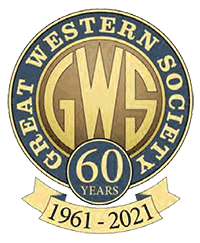Signalbox Equipment and Furniture
Introduction
The interiors of the two signal boxes at Didcot are very different, yet both have been carefully restored and fitted out as accurate representations of signal boxes of their period.
Radstock North Box illustrates how a Great Western box would have looked in the 1930's before the onset of World War 2. It has a solid fuel stove, linoleum on the floor, a conventional block shelf with a selection of period instruments and the usual utilitarian furniture common in boxes of this period.
Frome Mineral Junction Cabin however, has been furnished as far as possible in the style of the mid-1870's in which it was built, to complement the broad-gauge era equipment at this end of the site. The floor is left therefore, as bare boards, there is little instrumentation, and illumination is by oil-lamp and the open wood fire.
The only slightly out-of-period feature is the Webb-Thompson Electric Train Staff equipment which was not introduced onto the GWR until 1891. This apparatus is of course necessary as a pair to the one in Radstock box so a slight historical compromise has been accepted.
Where the original location of equipment is known details are given below although particularly in the case of smaller objects much has been acquired third or fourth hand or bought as railwayana in which case the original location is often lost.
Radstock North Box - Furniture
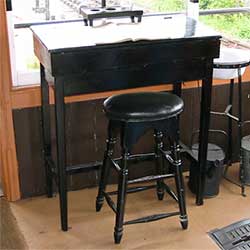 R J Heron - 30-Apr-2002 |
Train Register Desk & StoolA desk to GWR Standard design, with oval stool. The desk is designed to be tall enough for the signalmen to write upon whilst standing, and inside it is kept the rule book and appendices together with all the necessary forms for emergency working etc. On the desk is kept the train register and the essential pens and inkwell. This furniture was original to, and recovered with, Radstock North Box. (Vaughan. 1984. pp.130-131) |
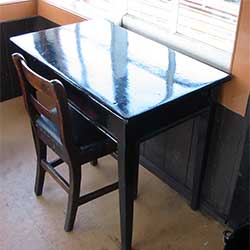 R J Heron - 21-Apr-2002 |
Table & ChairStandard issue 'kitchen' table, and chair with padded seat. Provided for use at mealtimes i.e. whenever a suitable break in the flow of traffic presents itself. The table was original to, and recovered with, Radstock North Box. (Vaughan. 1984. p131) |
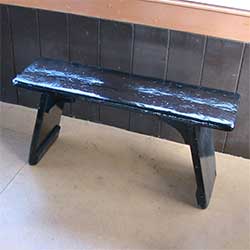 R J Heron - 5-May-2002 |
BenchStandard issue bench, simply made from three pieces of wood, and provided for the use of any extra staff who are needed in the box from time to time. This furniture was original to, and recovered with, Radstock North Box . (Vaughan. 1984. pp. 131) |
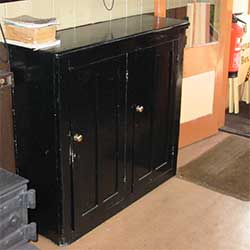 R J Heron - 5-May-2002 |
CupboardTwo door locker, with space on top convenient for displaying the working timetable and notices of extra trains, whilst inside are kept the soaps, Brasso, cotton waste and emery cloth required to keep the box spick and span. This furniture was original to, and recovered with, Radstock North Box. (Vaughan. 1984. pp. 131) |
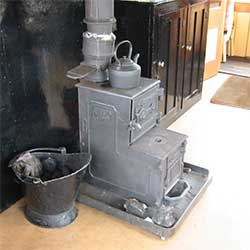 R J Heron - 30-Apr-2002 |
Coal Burning StoveOften thought to be the most important piece of S&T equipment ever invented - for without it there is no tea! |
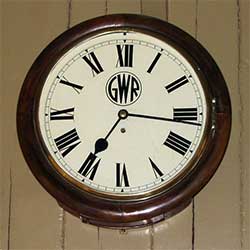 R J Heron - 30-Apr-2002 |
GWR ClockPendulum clock - 12" diameter short case |
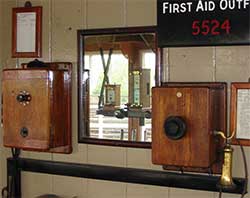 R J Heron - 21-Apr-2002 |
TelephonesA 4 way omnibus and a wooden case general 'phone are provided. |
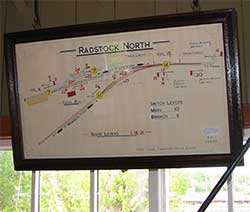 R J Heron - 5-May-2002 |
Signalbox Diagram |
Other EquipmentOther period Great Western features of Radstock North box interior, not illustrated above, include;
|
|
Radstock North Box - Instrumentation
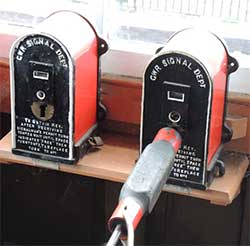 R J Heron - 13-Apr-2021 |
Annetts Key Release InstrumentsAnnetts Key Release Instruments - A and C types |
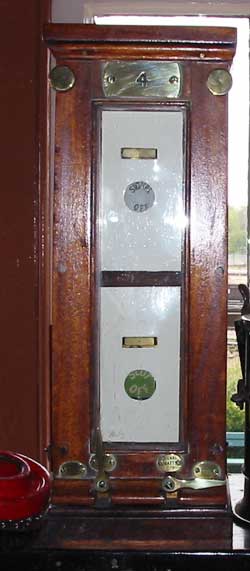 R J Heron - 21-Apr-2002 |
Signal R4 Combined Arm and Lamp RepeaterWooden Case repeater apparatus type 'G'. Fitted with Flags type 1 and 4 |
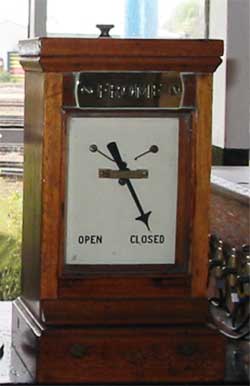 R J Heron - 21-Apr-2002 |
Box Open/Closed IndicatorWooden Case signalbox open/closed indicator, used to indicate the state of Frome Mineral Junction Cabin. |
 R J Heron - 25-May-2014 |
Block SwitchWooden Case block circuit switch. Single pole 6-way. These switches entered general use from 1909 with the purpose of permitting signal boxes to be taken out of circuit at certain times of the day or at weekends (Adams. 1993. p.214) |
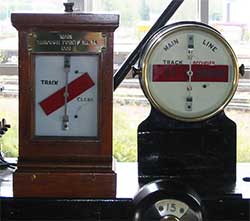 R J Heron - 21-Apr-2002 |
Track circuit indicators
Track circuits were originally devised in America in 1872 but were first used in Britain by Sykes in 1876 at Crystal Palace. The first known use of track circuits on the Great Western was as part of the Basildon (between Goring and Pangbourne) scheme of Intermediate Block Signals in 1907 (Kichenside & Williams. 1998. p.104, 110; Adams. 1993. p.216) |
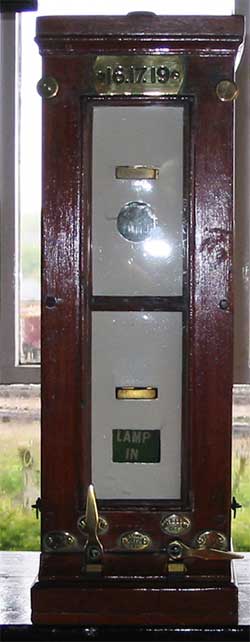 R J Heron - 30-Apr-2002 |
Signal R16/17/19 Combined Arm and Lamp RepeaterWooden Case repeater apparatus type 'B' fitted with Flags types 1 and 11 and 'Lamp Out' warning bell |
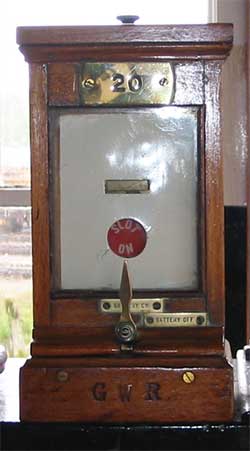 R J Heron - 30-Apr-2002 |
Signal R20 Slot RepeaterWooden Case repeater apparatus type 'A' fitted with Flag type 4 |
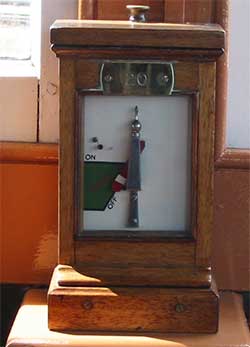 R J Heron - 21-Apr-2002 |
Signal R20 Arm RepeaterWooden Case 'miniature signal arm' repeater apparatus. Used to repeat the indication of Signal R20 which is out of sight of the box. |
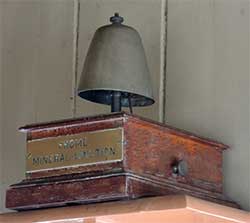 R J Heron - 13-Apr-2021 |
Block BellThis is a Non-Tapper wooden case block bell instrument with 'Cow' type bell. Non-tapper bells are used in this installation as the bell keys are integral with the Webb-Thompson single line equipment. See also information under 'Frome Cabin', below. |
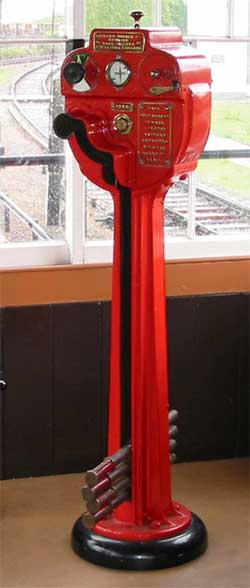 R J Heron - 30-Apr-2002 |
Webb-Thompson Electric Train Staff InstrumentThis type of Instrument, developed by the L&NWR's engineers, was first used on the Great Western between Parsons Tunnel and Dawlish boxes in 1891, and was to be found in general use on single line sections between Exeter and Penzance by 1893. The Staffs themselves are iron tubes of nearly 2ft length, and are of such weight as to preclude any kind of high, or even moderate, speed exchange. Such staff apparatus ceased to be installed on Great Western following the invention by their then Chief Signal and Telegraph Engineer, Alfred Thomas Blackall, of the Key Token in 1912. However like much railway equipment, once installed it could be very long-lived indeed. The machines at Didcot were originally from the Ross-on-Wye area and were purchased in February 1979. (Adams.1993. p.30; Vaughan. 1984, pp.12-13; GW Echo No. 67. Autumn 1979. p.16) |
Frome Mineral Junction Cabin
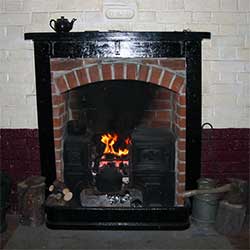 R J Heron - 25-Oct-2002 |
FireplaceOpen fire with small warming oven, and fire surround together with a GWR cast iron fender and a suitable coal scuttle. The fire surround was original to, and recovered with, Frome North Box. |
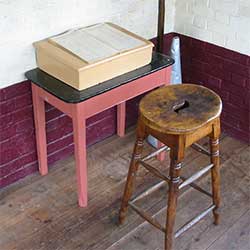 R J Heron - 21-Apr-2002 |
Table and ChairsTable, writing slope, wooden stool and bench (not illustrated). The table and writing slope were original to, and recovered with, Frome North Box whilst the bench, similar to that in Radstock Box (illustrated above) was recovered from Bruton Signalbox. |
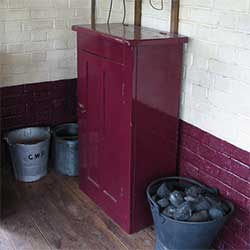 R J Heron - 21-Apr-2002 |
Signal Box CupboardOriginal to, and recovered with, Frome North Box. |
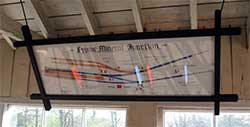 R J Heron - 13-Apr-2021 |
Signal Box DiagramOf the older style with much darker inks and showing mixed gauge trackwork. This is based on an original diagram for Slough East which is in the Society’s collection |
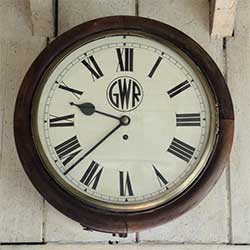 R J Heron - 13-Apr-2021 |
GWR Clock |
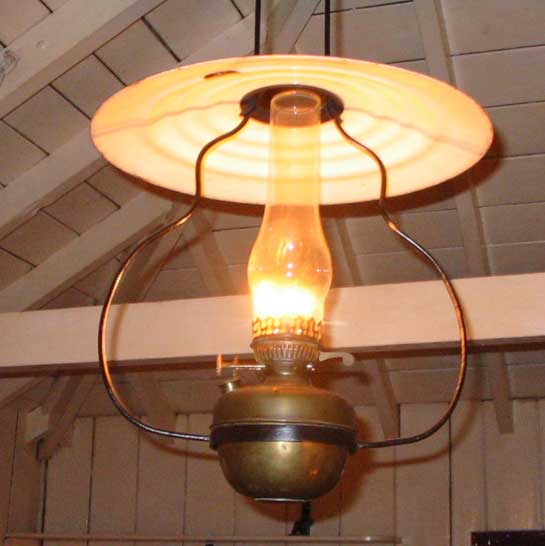 R J Heron - 25-Oct-2002 |
Oil LampThe hanging variety. The lamp was original to, and recovered with, Frome North Box. |
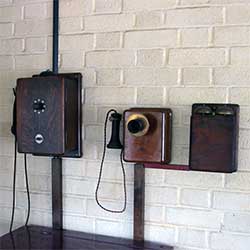 R J Heron - 21-Apr-2002 |
TelephonesBoth an omnibus phone and a general phone are provided, the latter having bells in a separate enclosure. |
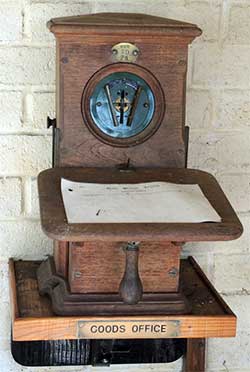 R J Heron - 13-Apr-2021 |
Single Needle Telegraph InstrumentThese instruments, invented in the 1850's were used to communicate by flicking the needle to left or right to produce letters in a similar fashion to Morse code (invented in 1844 by Samuel Morse), using left for dot and right for dash. This type of instrument was invented by Charles Ernest del Diana-Spagnoletti, first Telegraph Superintendent of the GWR, from 1855 to 1891. The instrument at Didcot has no signalling function, being merely intended to facilitate communication with the Goods Office in the Transfer Shed. (Adams. 1993. p.222; Kichenside & Williams. 1998. pp.44-45; Vaughan 1984. p.10) |
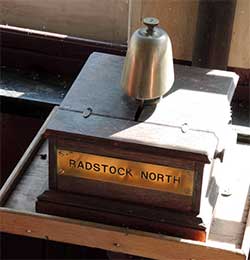 R J Heron - 13-Apr-2021 |
Block BellThe single strike electric bell was developed for railway use by Charles Walker, Telegraph Superintendent of the SER, by 1851. Such bells have been the primary method of communication between signalboxes ever since, being less open to misinterpretation than telephone messages. Non-tapper bells are used in this installation as the bell keys are integral with the Webb-Thompson single line equipment. This particular bell was purchased from Cefn Junction (Junction of the GW and the Port Talbot Railway on the Tondu to Port Talbot line). (Kichenside & Williams. 1998. p.45) |
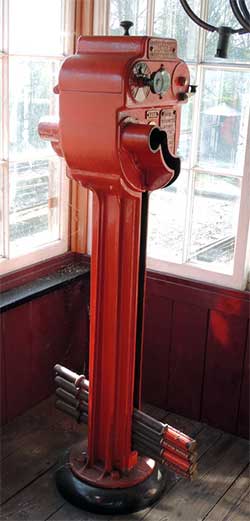 R J Heron - 13-Apr-2021 |
Webb-Thompson Electric Train Staff InstrumentThis type of Instrument, developed by the L&NWR's engineers, was first used on the Great Western between Parsons Tunnel and Dawlish boxes in 1891, and was to be found in general use on single line sections between Exeter and Penzance by 1893. The Staffs themselves are iron tubes of nearly 2ft length, and are of such weight as to preclude any kind of high, or even moderate, speed exchange. Such staff apparatus ceased to be installed on Great Western following the invention by their then Chief Signal and Telegraph Engineer, Alfred Thomas Blackall, of the Key Token in 1912. However like much railway equipment, once installed it could be very long-lived indeed. The machines at Didcot were originally from the Ross-on-Wye area, and were purchased in February 1979 (Adams. 1993. p.30; Vaughan. 1984, pp.12-13; GW Echo No. 67. Autumn 1979. p.16) |
Other EquipmentOther period Great Western features of Frome Signal Cabin interior, not illustrated above, include;
|
|
Bibliography
Adams, William, ed. 1993. Encyclopaedia of the Great Western Railway. Patrick Stephens Limited. Sparkford, Somerset. ISBN 1 85260 329 1 |
Kichenside, Geoffrey. & Williams, Alan. 1998. Two Centuries of Railway Signalling. Oxford Publishing Company, Sparkford, Somerset. ISBN 0 86093 541 8 |
Vaughan, Adrian. 1984. A Pictorial Record of Great Western Signalling (Revised). Oxford Publishing Co. Poole, Dorset. ISBN 0 86093 346 6 |
In addition, various copies of the Great Western Echo (GW Echo), Great Western Society National Newsletter (GWS NN) and Great Western Society (Bristol Group) News (BGN), all published by the Great Western Society, have been consulted.
